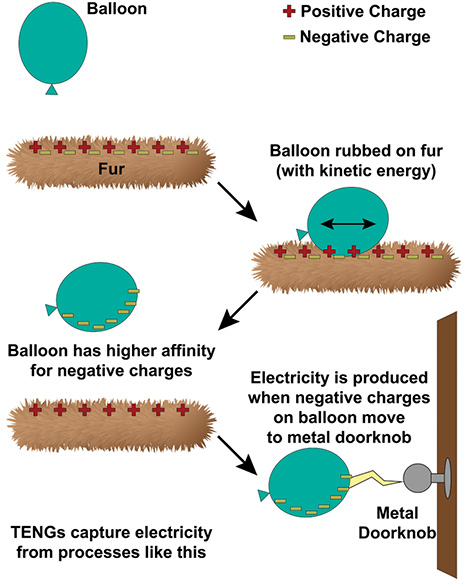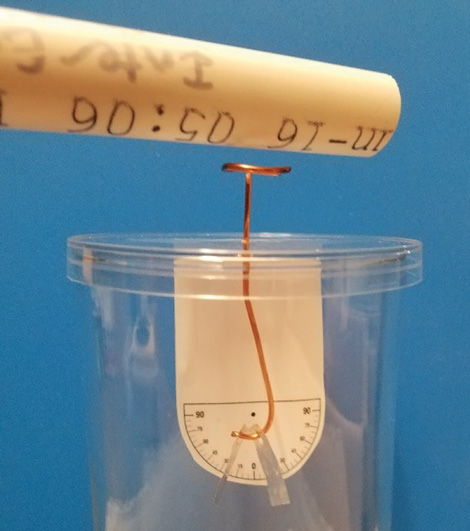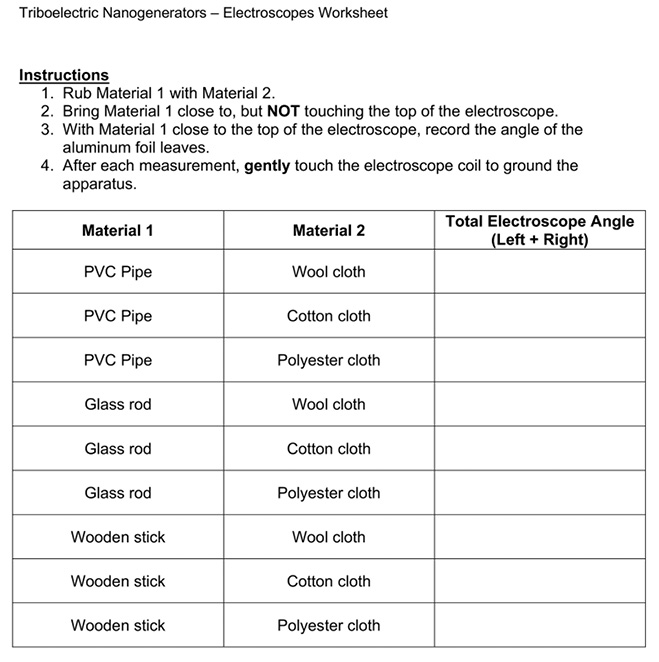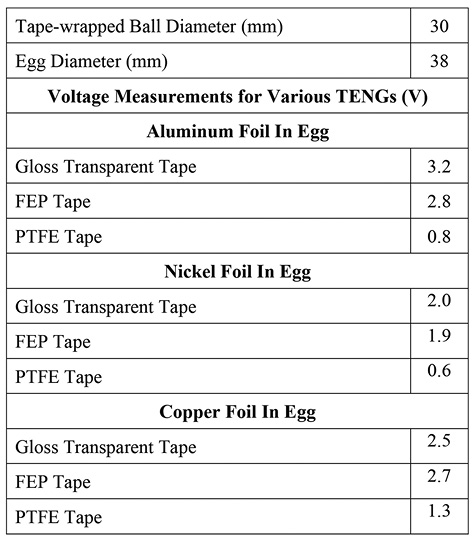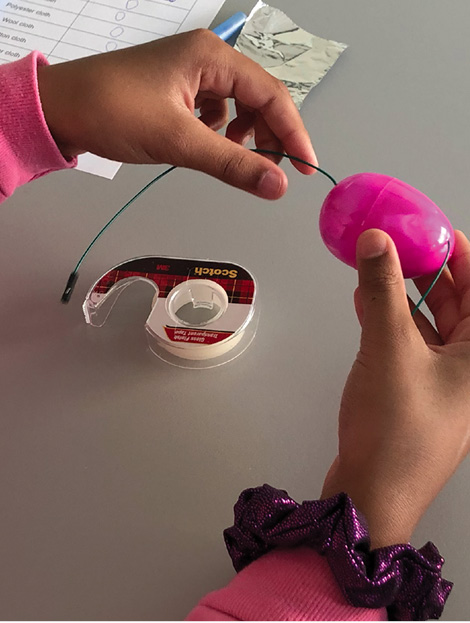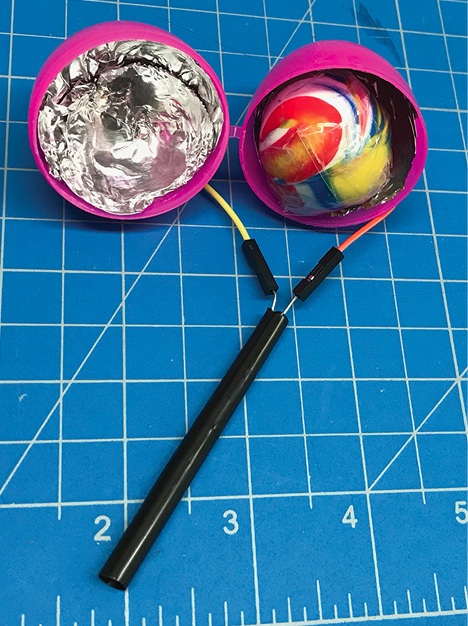Feature
Sparking a Movement
DIY triboelectricity experiments
The Science Teacher—January/February 2021 (Volume 88, Issue 3)
By Matthew D. Stilwell, Chunhua Yao, Dale Vajko, Kelly Jeffery, Douglas Powell, Xudong Wang, and Anne Lynn Gillian-Daniel

In response to COVID-19, we have found these nanogenerators to be an inexpensive and engaging at-home science activity.
What if “every breath you take, every move you make” (Sting 1983) could be harnessed to produce renewable energy? Triboelectric nanogenerators (TENGs) are state-of-the-art devices researchers are studying to do just that—convert kinetic energy into electrical energy at the source (Saurabh Rathore 2018). This type of electrical energy is called triboelectricity, commonly experienced as static electricity, and is produced when two materials, such as a rubber balloon and human hair, come into contact, exchanging and separating charges, producing a voltage (Figure 1).
TENGs create triboelectricity through the use of two materials, one that develops a positive charge and one that develops a negative charge. Triboelectricity is produced when the materials within the TENG are repeatedly brought into contact and separated. Typically, the kinetic energy from movement like walking or dancing is dissipated as heat and sound (Corrales, Chartier, and Devanathan 2005), but TENGs convert this kinetic energy into useful electricity that can power small electronics such as cell phones. This article details how students can build a simple, state-of-the-art, renewable energy device; experiment with circuits; and explore how scientists and engineers exploit surface-area-to-volume ratios to achieve desired results.
Introducing triboelectricity
We begin our discussion with a simple, eye-catching, and familiar demonstration of triboelectricity, i.e., static electricity. Students can rub a balloon with hair or fur and observe how the two objects attract one another. Alternatively, students can run a plastic comb through hair or fur, charging the comb and enabling it to pick up small pieces of plastic or paper in close proximity. Van de Graaff generators produce triboelectricity and allow for exciting demonstrations (please follow all safety considerations with your Van de Graaff generator!). See Online Connections for additional ideas and an excellent PhET simulation that demonstrates how electrical charges are exchanged when two materials come into contact and the effect the charge exchange has on the material’s behavior.
Exploring the triboelectric series
Two important concepts of triboelectricity that we want to emphasize are that: (1) when two materials with different charge affinities come into contact with one another, they donate or accept electrons, and (2) some materials are more amenable to accepting electrons, while others are more amenable to donating electrons. To drive these concepts home, students recreated a small section of the triboelectric series (Zou et al. 2019), a ranking of materials’ affinity for positive or negative charges.
We gave groups of students six different materials: three rods (wood, glass, PVC) and three cloths (cotton, wool, polyester). Using a DIY electroscope (Figure 2; see Online Connections for original source and our instructions) that we built prior to the activity and that students can build themselves, students tested every combination of rod and cloth in an attempt to create a subsection of the triboelectric series. Rubbing a rod with a cloth separates charges, and then bringing the rod close to the electroscope coil induces a charge gradient in the electroscope, causing the aluminum leaves to repel one another and enabling the students to measure the angle of deflection, and thus electrification. The larger the angle, the greater the amount of charge that was separated, and the further apart the materials are on the triboelectric series. Students record their results (Figure 3) for each combination of rod and cloth.
After the demonstration of triboelectricity and investigation into the triboelectric series, we activate student’s prior knowledge around energy and charge carriers. We ask students to explain where the energy to separate the aluminum leaves in the electroscope came from (kinetic energy from rubbing causes triboelectrification, which, when the rod is brought close to the coil, causes the leaves to separate). Additionally, we discuss the atomic charge carriers (protons carry positive charges, neutrons carry no charge, electrons carry negative charge), and charge carrier mobility, highlighting that electrons are the most mobile and can be transferred between atoms, while protons and neutrons are bound in the nucleus of an atom (Saurabh Rathore, Swain, and Ghadai 2018). We then confirm that like charges repel and opposite charges attract.
Building the nanogenerator
After completing the electroscope activity, we show students how a nanogenerator operates and the steps for constructing one from a plastic egg (see Online Connections). When the nanogenerator is shaken, a tape-covered ball inside bounces against the aluminum foil covering the inside of the egg, accepting electrons from the aluminum foil and then transferring them to the other side of the egg (Figure 4). The electrons conduct through the aluminum foil and connected wire on the other side, through the LED (producing a flash of light), the next wire, and finally back to the first piece of foil, rebalancing the charges. The materials and instructions to build a triboelectric nanogenerator are listed below. This method has worked for nearly all of the students (>95%) who followed the instructions; additional tips are included in the “Feedback for successful TENG construction” section.
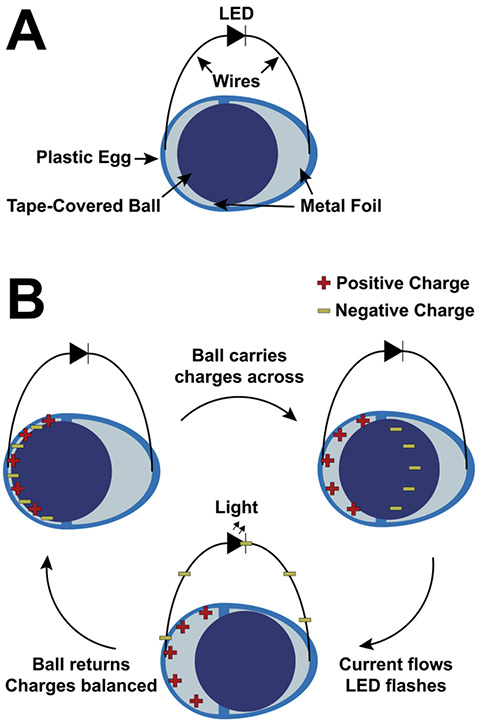
TENG schematic and device operation.
Nanogenerator materials
- Plastic egg (standard Easter eggs are 2.25” tall and work well)
- heavy duty kitchen aluminum foil
- Female-to-female jumper wires or regular copper wires, stripped
- Bouncy balls, (~32 mm diameter) NOTE: the diameter of the ball must be a few millimeters smaller than the inner diameter of the plastic egg
- Double-sided tape
- Gloss finish transparent office tape
- 5 mm (T-1 ¾) clear green LEDs, forward voltage 2.9-3.1 V (green is the easiest LED color to see)
- Black straws (0.21” diameter; standard straws are about this size)
- •Scissors
Instructions
- Strip a 1–2 cm section at the end of the jumper or copper wires to expose the metal within. The aluminum foil and metal wires need to touch in order for current to flow.
- Insert one wire into the small plastic hole on the bottom of each half of the plastic egg. If there is no hole, a small nail or scissors can be used to make one. Using the double-sided tape, secure the wires to the inside of the egg, ensuring that the exposed metal wires are NOT covered by the tape. Place several more pieces of the double-sided tape on the inside of the plastic egg to hold the aluminum foil in place.
- Cut a square piece of aluminum foil that is just larger than the width of the plastic egg. Push the aluminum foil into the egg and against the sides. Using scissors, trim the aluminum foil so that no foil sticks out over the edge of the egg. Push the edges of the aluminum foil away from the edges of the egg to create a gap between the aluminum foil pieces when the egg is closed. The gap between foils must extend around the entire inner circumference of the egg for the nanogenerator to work, otherwise the charges will rejoin inside the egg rather than traveling through the wires.
- Wrap the bouncy ball with tape. The ball should be completely covered in one layer of tape, using the least amount of tape possible to ensure free movement of the ball in the egg.
- Insert the LED into the wire jumpers outside the egg. The egg will be shaken, so ensure this connection is secure.
- Insert the LED into the black straw just enough to cover the bulb and secure the LED.
- Shake the egg back and forth, transferring the ball from one half of the egg to the other. Each time the ball hits one side of the egg, the LED should blink on. The side of the egg that causes the LED to blink will depend on the orientation of the LED, such that reversing the leads of the LED will cause the opposite side of the egg to turn the LED on.
Extensions and modifications
Several options are available for inquiry-based modifications. As an engineering optimization problem, students can use the triboelectric series to predict which combinations of metal foil, such as copper or nickel, and tape, such as frosted office tape, polytetrafluoroethylene (PTFE) tape, or fluorinated ethylene propylene (FEP) tape, will produce TENGs with the highest voltage. Students can then build the different TENGs and use a voltmeter or oscilloscope to measure the voltage output. See Figure 5 for a table of voltage outputs from different combinations.
In addition, students can alter the size ratio of ball to plastic egg, change the plastic egg to a container of another geometry, or use multiple smaller balls. In addition, TENGs can be created with alternate geometries, such as the ones produced by Zhang et al. (Zhang et al. 2017). Several types of TENGs can be seen in Figures 7 and 8. For advanced groups, students can attempt to power a small electronic device such as a wristwatch using their TENGs, similar to the work done by Cheng et al. (Cheng et al. 2019).
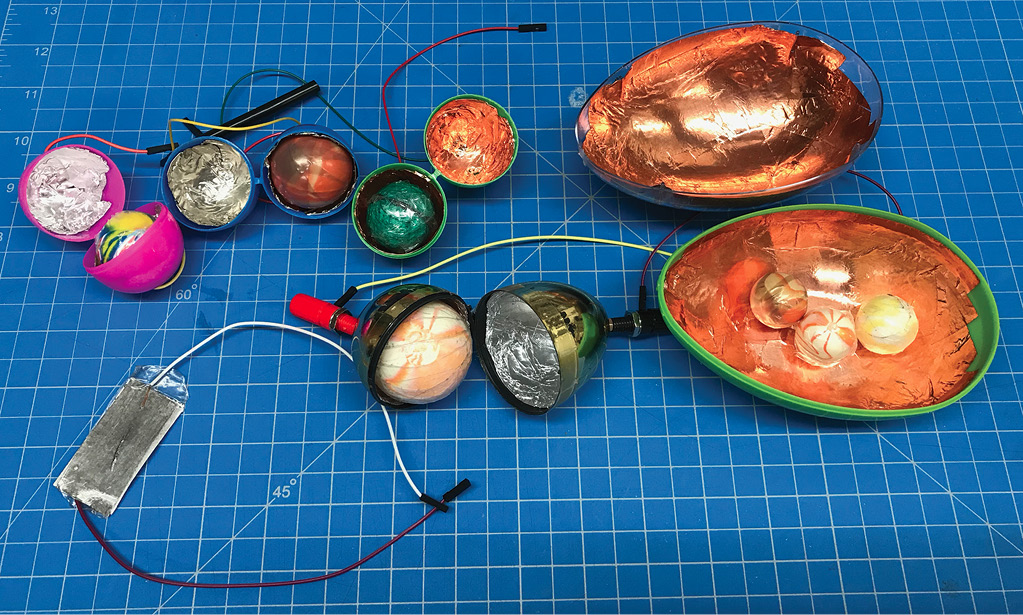
A Collection of TENGs. Clockwise from the top left: aluminum foil and office tape; nickel foil and PTFE tape; copper foil and FEP tape; oblong and largest egg with copper foil and multiple smaller balls wrapped in office tape; larger egg with aluminum foil and FEP tape; and paper, pencil and FEP tape. (Photo Credit: Matthew Stilwell)
Feedback for successful TENG construction and classroom management
We used formative assessments while designing this activity to gauge what students knew and learned, and what aspects of the activity proved challenging. These assessments led to iterative design improvements of the TENG. We led this activity during 14 field trips to a large research university for over 330 upper-middle school and high school students. Two local high school teachers also led the activity in their classrooms. We found a few common sources of error that prevent the proper functioning of the TENG:
- When the egg is closed, the aluminum foil on one half should NOT contact the aluminum foil on the other half. If the foils touch, they will conduct and prevent charge separation and current flow through the LED.
- When the egg is closed, you should feel the ball moving from one side to the other. When wrapping the ball with tape, cover it with a single layer of tape and no more. Excess tape can impede the ball from moving and prevent the ball from transferring charge.
- Only a single layer of aluminum foil is needed in each egg half. Stacking multiple layers of foil will create extra bulk, restraining the ball.
- Students must be careful to NOT cover the exposed leads of their wires with tape, as the exposed ends of the wire are critical for current flow. A discussion of conductors (the wire and aluminum foil) and insulators (tape) may be useful.
- Staging the materials (only provide eggs, double-sided tape, and wires at first, then provide foil, then ball and transparent tape, then LED and straw) and checking for completion after each step can help decrease the cognitive load for construction and ensure greater rates of success.
- Students can build multiple devices in pairs or small groups if they need more guidance.
Assessments
Many options for assessments exist, such as quizzes related to electricity or student reflections on the design and importance of the work. Students can draw diagrams explaining the mechanism of the TENGs and how the current flows through the device. Questions such as “why does there need to be a gap in the foil between the two sides of the TENG?” and “why did we have to take care not to cover the wires with tape?” can be used to assess students’ understanding of circuits, conductivity, and current flow.
Additional questions such as “Could these devices be used to power the school, and how would you accomplish that task?” “What changes would you make to the TENGs to increase their power output?” “Where might this technology be best implemented?” can stimulate student’s creativity and design thinking. If voltmeters or oscilloscopes are available, students can demonstrate proficiency in HS-PS3-3 by refining the device while satisfying a set of constraints such as power output, cost, and size of device.
Theoretical optimization of the TENGs
Students should observe that the brightness of the LED in these TENGs is relatively low (the black straws aid in visualizing the LEDs; green LEDs are easiest to see), which can lead to an interesting discussion on electronics and surface-area-to-volume ratios. The brightness of an LED is, within limits, linearly dependent on the current flowing through it. These TENGs produce a voltage large enough to illuminate the LED, but a low current, on the order of tens of microamps, that causes the LED brightness to be low.
We asked the students how they might design nanogenerators to produce more current and thus brighter lights. For this TENG design, the only part of the ball that contacts the aluminum foil is the tape-covered surface. Therefore, the surface of the ball is responsible for triboelectrification. Since the ball is spherical, we know that the surface area (SA) and volume (V) depend on the radius of the sphere (r):
SA = 4πr2
V = (4πr3)/3
The surface-area-to-volume ratio is then:
SA/V = (4πr2)/((4πr3)/3) = 3/r
Without employing different materials or changing the TENG geometry, altering the surface-area-to-volume ratio is our only option for optimizing charge separation, and thus electricity generation, within the device. With the above equation, we see that as the radius, r, becomes larger, the surface-area-to-volume ratio becomes smaller, and that as r becomes smaller, the surface-area-to-volume ratio becomes larger.
In order to maximize the charge separation with these materials and this geometry, we want to maximize the surface-area-to-volume ratio. Scientists and engineers greatly increase the surface-area-to-volume ratio by working at the nanoscale (on the order of 1–100nm), enabling greater charge separation with the same amount of materials. Since the nanoscale is so much smaller than the TENGs outlined in this activity, scientists and engineers can essentially pack hundreds of thousands of nanogenerators into the same volume, drastically increasing the total charge separation and energy generation. Scientists and engineers are currently designing nanoscale triboelectric nanogenerators to maximize the energy generation for myriad uses, from flooring that harvests the energy of footsteps (Yao et al. 2016) to bandages that electrically stimulate wounds, accelerating healing times (Long et al. 2018).
Conclusion
Triboelectric nanogenerators provide another tool for electricity generation in a world with increasing demands for renewable energy. These cutting-edge devices promise to reduce the need for batteries in small electronics and make a valuable addition to humanity’s portfolio of sustainable, nonpolluting energy generation technologies. Global challenges such as climate change require us to keep moving, and to harness the kinetic energy at the same time!
Acknowledgments
This research was primarily supported by NSF through the University of Wisconsin Materials Research Science and Engineering Center (DMR-1720415). Any opinions, findings and conclusions, or recommendations expressed in this report are those of the authors and do not necessarily reflect the views of the Foundation.
Online Connections
Original electroscope instructions: https://www.youtube.com/watch?v=ViZNgU-Yt-Y
Written electroscope instructions and materials list: https://education.mrsec.wisc.edu/do-it-yourself-electroscope/
Triboelectricity PhET: https://phet.colorado.edu/sims/html/balloons-and-static-electricity/latest/balloons-and-static-electricity_en.html
Background on triboelectricity: https://education.mrsec.wisc.edu/triboelectricity/
Written TENG instructions, materials list, and construction guide: https://education.mrsec.wisc.edu/triboelectric-nanogenerator/
Matthew D. Stilwell (mstilwell@wisc.edu) is the Associate Director of Education at the University of Wisconsin–Madison (UW) Materials Research Science and Engineering Center (MRSEC) in Madison, Wisconsin, Chunhua Yao is a Research Assistant at the UW in Madison, Wisconsin, Dale Vajko is a Chemistry and Math Teacher at Pembine High School in Pembine, Wisconsin, Kelly Jeffery is a Biology, Chemistry, and Physics Teacher at McFarland High School in McFarland, Wisconsin, Douglas Powell is a Project Assistant at the UW MRSEC in Madison, Wisconsin, Xudong Wang is a Materials Science & Engineering Professor at the UW in Madison, Wisconsin, and Anne Lynn Gillian-Daniel (agillian@wisc.edu) is the Director of Education at the UW MRSEC in Madison, Wisconsin.
Chemistry Crosscutting Concepts Engineering Interdisciplinary Labs NGSS Physical Science Physics Science and Engineering Practices STEM High School


